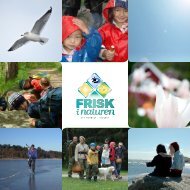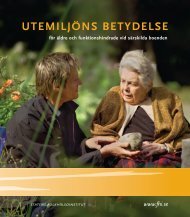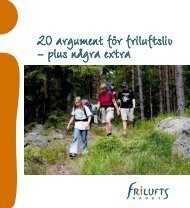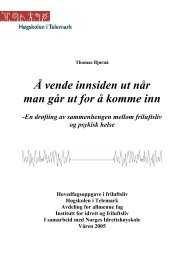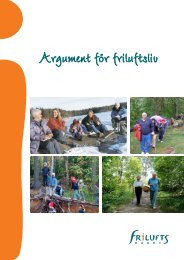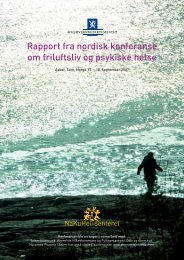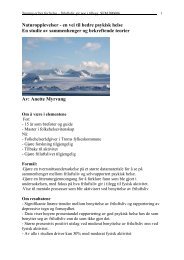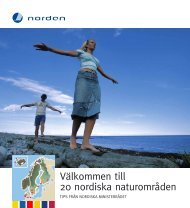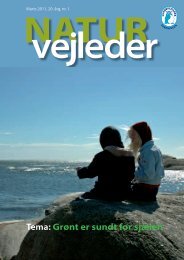Green Care: A Conceptual Framework - Frisk i naturen
Green Care: A Conceptual Framework - Frisk i naturen
Green Care: A Conceptual Framework - Frisk i naturen
You also want an ePaper? Increase the reach of your titles
YUMPU automatically turns print PDFs into web optimized ePapers that Google loves.
“The importance of feeling connected is an early theme in<br />
the writing of both ecologists [references are cited] and<br />
ecopsychologists [references are cited]. They have argued<br />
that this connection to nature is a key component of fostering<br />
ecological behavior. For example, the influential ecologist<br />
Leopold (1949) wrote years ago: ‘We abuse land because we<br />
regard it as a commodity belonging to us. When we see land<br />
as a community to which we belong, we may begin to use it<br />
with love and respect.” (p. 504)<br />
Mayer and Frantz have also developed a ‘Connectedness to Nature Scale’<br />
(CNS), which is a “new measure of individuals’ trait levels of feeling<br />
emotionally connected to the natural world” (Mayer and Frantz, 2004,<br />
p. 460). In recent research (Hine et al, 2008), connectedness to nature<br />
has also been shown to be related to an increase in both awareness of<br />
environmental issues and in environmentally friendly behaviour.<br />
Given that ‘connectedness’ to nature is both desirable and beneficial, then<br />
it follows that a disconnection from nature is likely to have negative effects<br />
both on the psychological health of individuals and on the way populations<br />
value and conserve our natural environment.<br />
It also follows that many people who are ill or distressed would benefit<br />
from a reconnection to nature and this premise forms the basis of green<br />
care.<br />
The key element in all the different forms of green care is to use nature to<br />
produce health, social or educational benefits to a wide range of vulnerable<br />
people.<br />
2.3.4 Using nature-connectedness in therapy<br />
There are some published examples of the “greening” of counselling<br />
and psychotherapy in which a natural element is introduced into a more<br />
traditional therapy relationship. Burns’ (1998) approach to hypnosis<br />
makes extensive use of nature-based exercises. Linden and Grut (2002)<br />
describe psychotherapeutic work during allotment gardening with victims<br />
of torture. Berger’s “nature-informed therapy” uses the relationship with<br />
nature as the key reference point for therapy (Berger and McLeod, 2006).<br />
Hegarty (2007) describes imaginal and in-vivo nature-based therapy.<br />
20 <strong>Green</strong> <strong>Care</strong>: A <strong>Conceptual</strong> <strong>Framework</strong>



